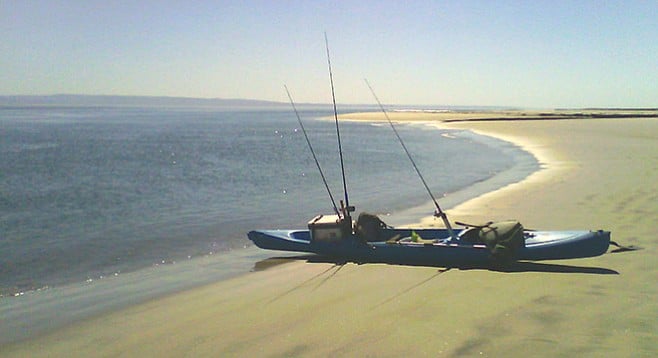 Facebook
Facebook
 X
X
 Instagram
Instagram
 TikTok
TikTok
 Youtube
Youtube

San Quintín sits about 200 miles south of San Diego near the southern end of the Valle de Guadalupe. The large bay there is ringed by inactive volcanoes; the main industry is berry farming. San Martin Island and offshore banks provide structure for rockcod, big lingcod, yellowtail, and white seabass. Aqua-culture enterprises in the bay raise oysters, abalone, and lobster. Inside the bay, the main catch is sand bass and halibut. Occasional black seabass and white seabass show up in the current-cut ruts up to 60 feet deep at the mouth.
On Sunday, May 3, a friend and I were kayak-fishing the nearly mile-wide bay mouth. I saw two people in wetsuits paddling surfboards and towing a jet ski with their leashes. The tide was going out, dumping, and they were going sideways. I paddled over and offered to help tow them with my kayak. It was a guy about 40 and his son, maybe 13. The dad said, “No, we’re fine.” I said, “No, you are not. The tide is dumping and you are going out quicker than across, not a good thing. Big surf and sand bars out there.” I stayed with them about five minutes and asked again, “You sure? You have a kilometer to go.” He said, “Okay, maybe so, but we don’t have a rope.” I returned, “Got two.” I lassoed the handlebars and had him clip to my back T-handle and off we went, except we were going out faster than across as the tide was speeding up and we were in the throat of it. He said, “Wow, we were in trouble.”
My friend hooked up in front of me and we started making ground with two kayaks. After 15 minutes or so we started slowing down; I looked back and the kid was sitting on the ski pecking away at his iPhone and the ski was sideways. His dad had paddled ahead on his board. I told junior to straighten it out. He said, “The steering doesn’t work when it’s not running.” I told him to move the knot back to center or even past it and it would straighten out. He did so like a pro, and we soon made it to the beach.


San Quintín sits about 200 miles south of San Diego near the southern end of the Valle de Guadalupe. The large bay there is ringed by inactive volcanoes; the main industry is berry farming. San Martin Island and offshore banks provide structure for rockcod, big lingcod, yellowtail, and white seabass. Aqua-culture enterprises in the bay raise oysters, abalone, and lobster. Inside the bay, the main catch is sand bass and halibut. Occasional black seabass and white seabass show up in the current-cut ruts up to 60 feet deep at the mouth.
On Sunday, May 3, a friend and I were kayak-fishing the nearly mile-wide bay mouth. I saw two people in wetsuits paddling surfboards and towing a jet ski with their leashes. The tide was going out, dumping, and they were going sideways. I paddled over and offered to help tow them with my kayak. It was a guy about 40 and his son, maybe 13. The dad said, “No, we’re fine.” I said, “No, you are not. The tide is dumping and you are going out quicker than across, not a good thing. Big surf and sand bars out there.” I stayed with them about five minutes and asked again, “You sure? You have a kilometer to go.” He said, “Okay, maybe so, but we don’t have a rope.” I returned, “Got two.” I lassoed the handlebars and had him clip to my back T-handle and off we went, except we were going out faster than across as the tide was speeding up and we were in the throat of it. He said, “Wow, we were in trouble.”
My friend hooked up in front of me and we started making ground with two kayaks. After 15 minutes or so we started slowing down; I looked back and the kid was sitting on the ski pecking away at his iPhone and the ski was sideways. His dad had paddled ahead on his board. I told junior to straighten it out. He said, “The steering doesn’t work when it’s not running.” I told him to move the knot back to center or even past it and it would straighten out. He did so like a pro, and we soon made it to the beach.
Comments